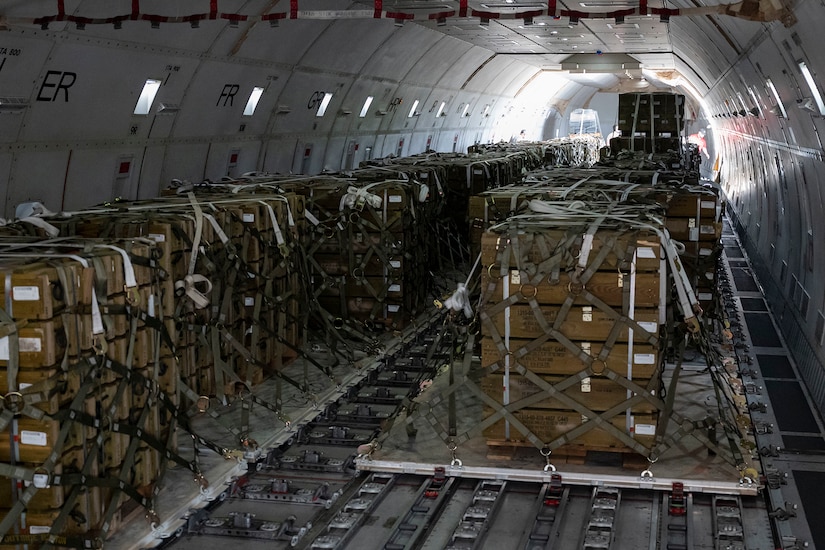Ahead of the Ukraine Defense Contact Group’s second anniversary, National Armaments Directors from UDCG member nations, the European Union and NATO gathered for the 11th time last week in Brussels.
“We’re all seeing how urgent the situation in Ukraine has become, and as [Defense Secretary Lloyd J. Austin III] emphasized at the recent session of the NATO-Ukraine Council, we must continue to push for immediate, concerted action on Ukraine’s priority requirements,” said William LaPlante, undersecretary of defense for acquisition and sustainment. “The National Armaments Directors are uniquely positioned to operationalize the guidance set forth by the UDCG at the ministerial level, and we are not — and cannot — let our foot off the gas.”
Focused on synchronizing international procurement, production and sustainment efforts, LaPlante co-chairs the forum alongside his Ukrainian counterpart, Lt. Gen. Ivan Havryliuk. Nearly 50 nations and multinational organizations participated in the session.
Defense officials said the group continues to identify and deliver solutions for Ukraine’s most pressing requirements in key capability areas — including ground-based, long-range fires; air defense systems; and maintenance and sustainment.
“Over the last year, nations have made vital commitments to provide capabilities to Ukraine and the NADs have likewise done a tremendous job getting the appropriate contracts in place,” LaPlante said. “But we’re at a point now where we need to be measuring the output of those efforts — and that means deliveries. As new and expanded production lines become fully operational, it’s imperative we’re making those commitments reality, and quickly at that.”
During the session, the undersecretary praised increases in co-development and co-production ventures — such as production of Patriot guidance enhanced missiles, known as GEM-Ts, in Germany — and called on attendees to replicate the approach.
“Current global demand far exceeds current capacity, so any effort that is enabling economies of scale, production expansion, and the acceleration of capability delivery is welcome,” he said.
Earlier this year, the NATO Support and Procurement Agency awarded a $5.6 billion contract to support the procurement of up to 1,000 GEM-T missiles by multiple European nations.
In the U.S., defense officials have said that production of 155 mm artillery ammunition recently surpassed 30,000 rounds per month. Through the opening of a new production facility in Mesquite, Texas, in May and other expansion efforts, output is expected to reach nearly 70,000 rounds per month by the end of year, the officials said. Funding included in the most recent national security supplemental signed by President Joe Biden on April 24 will enable production expansion beyond 100,000 rounds per month.
The security supplemental, worth roughly $95 billion in total, includes more than $60 billion for support to Ukraine. Following its passage, DOD announced the Biden Administration’s 56th tranche of equipment to be provided from DOD inventories to Ukraine since August 2021. This Presidential Drawdown Authority package has an estimated value of $1 billion and includes capabilities to support what a defense official characterized as Ukraine’s most urgent requirements, including air defense interceptors, artillery rounds, armored vehicles and antitank weapons.
The sustainment of forces and systems already donated to Ukraine remains equally important, officials said. During the meeting, leaders from the Ukraine Logistics Command, Security Assistance Group-Ukraine and International Donor Coordination Center provided an update on the maintenance and logistics requirements to keep capabilities in the fight, as well as efforts to reconstitute forces and build additional units.
“Ukraine is at a critical juncture, and anything we can do to increase mission capable rates will increase combat power and operational readiness,” said Assistant Secretary of Defense for Sustainment Christopher Lowman. “Even small percentage improvements in these areas have a direct and significant impact on the battlefield. We must continue to do more.”
Defense officials said the National Armaments Directors remain focused on locating, producing, and provisioning spare parts; enabling equipment such as generators and handling and diagnostics equipment; and subject matter experts to assist with training, telemaintenance and regional maintenance, repair and overhaul, defense officials said. This includes increasing the availability of technical data packages and translated technical manuals to enable repair closer to the point of need.
In support of Ukraine’s long-term success, the group is also augmenting the UDCG’s capability coalitions established at the ministerial level. For the first time, armaments directors from those nations leading capability coalitions provided updates and initial areas for direct engagement.
“If you want to get things done, you have to involve the [National Armaments Directors],” LaPlante said, “and that’s one of the primary reasons Secretary Austin asked me to convene this forum in support of the UDCG. His leadership has been extraordinary in pulling together this unprecedented group, and we will continue to drive action in any and every way we can.”
Since Russia’s illegal invasion of Ukraine on Feb. 24, 2022, the United States has committed more than $44.9 billion in security assistance. The Department of Defense has obligated on contract more than $13.6 billion through the Ukraine Security Assistance Initiative and more than $19.1 billion in additional funds to replenish equipment drawn down from U.S. stocks under Presidential Drawdown Authority.
Austin established the UDCG in 2022 to ensure that Ukraine has the capabilities that it needs to defend its people from Russian aggression and take back its sovereign territory. Together, UDCG nations have committed more than $89 billion in total security assistance to Ukraine. The group will convene for the 21st time on April 26.









